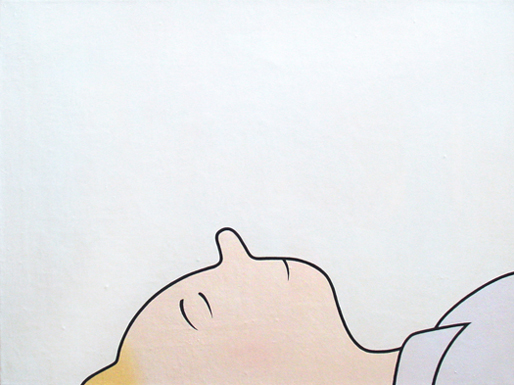I am hardly aware of myself but only of the sensation.
I am only the container of the feeling of ecstasy, of the feeling of rapture.[1]

Dejan Grba, Bored to Death, ulje na platnu, 1998-2001.
Tintin revisited. In the course of the ruptured iterability of a self. By the use of substitutes. Substituting instead of representing. Making possible an act of transformation by the mediation of some kind of displacement. By the conceptual use of the borrowed visually formed model. As the bearer of the perceptually represented idiomatic features of a personality. Deriving sense out of sensations. Inscribed into the surfaces of the delegated self. According to Norman Bryson, the conceptual and the perceptual aspects of a painting are just the opposite ends of the same axis, the conceptual being the substitutional one. Substituting images for images. All art is in a way conceptual, in the sense that all images are based on previous images and they are some kind of a relational model.
In the framework of identity-politics, an image may function as a substitute for a constantly lacking fixed form of an identity, then as a definition of it, then become the basic matrix for its recognition. Used in a citational sense, an image produces denotations in its intersection with all the schemata of recognition codified in iconology, its performative power resulting from the procedures ran by the iconographic code. In that respect an identity appears to be a sole byproduct of a deliberate misrecognition of the self in an image of a completely visual structure, which results in modeling one’s behaviour and beliefs according to it.
An image gives form to something. Subsuming it under a schema that in forms the subject and makes possible the process of its identification with something complete. Self enclosed and self sufficient. Which is to be repeated, reiterated, and provided with some transtemporal identity. As if disclosing some solidity behind the fluxes of sensations, which in a very simple and banal way point towards the radical extimity of any individual, with its intimate traits featured on the display of the signs of particularity.
The pleasures of viewing will accordingly be rooted in wholeness and repetition; the image will not tend to interrupt or break with the comfortable familiarity of the already known. A painting of plaisir will repeat, will confine to that kind of an image. Circumventing any traces of rapture or ecstasy. Circumventing enjoyment.
The sterile, aseptic image of Tintin, taken from the cartoon series and drained from any action, provides a perfect model for the painting of plaisir. A perfect catch, offering the pleasures of viewing. Only slightly disrupted, colonized with basic sensations, corporizing his body in a signifying way. Getting to the brinks of enjoyment.
-
Virginia Woolf, A Sketch of the Past in Moments of Being: Unpublished Autobiographical Writings, ed. Jeanne Schuylkind, p. 68, Harcourt Brace Jovanovich, New York & London, 1976. ↩
Stevan Vuković, Delegated Self, on the Brinks of Enjoyment, The Blue Lotus exhibition catalogue, Remont Gallery, Belgrade, 2001.